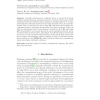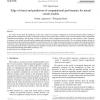978 search results - page 5 / 196 » Some neural networks compute, others don't |
IJCNN
2008
IEEE
14 years 2 months ago
2008
IEEE
— Spiking neural networks have been shown capable of simulating sigmoidal artificial neural networks providing promising evidence that they too are universal function approximat...
NC
2011
13 years 2 months ago
2011
We apply techniques from complexity theory to a model of biological cellular membranes known as membrane systems or P-systems. Like Boolean circuits, membrane systems are defined ...
CJ
2008
13 years 7 months ago
2008
This article advocates a new computing paradigm, called computing with time, that is capable of efficiently performing a certain class of computation, namely, searching in paralle...
NN
2007
Springer
13 years 7 months ago
2007
Springer
We analyze in this article the significance of the edge of chaos for real-time computations in neural microcircuit models consisting of spiking neurons and dynamic synapses. We �...
NC
2011
12 years 10 months ago
2011
In this paper, graph multiset transformation is introduced and studied as a novel type of parallel graph transformation. The basic idea is that graph transformation rules may be ap...


